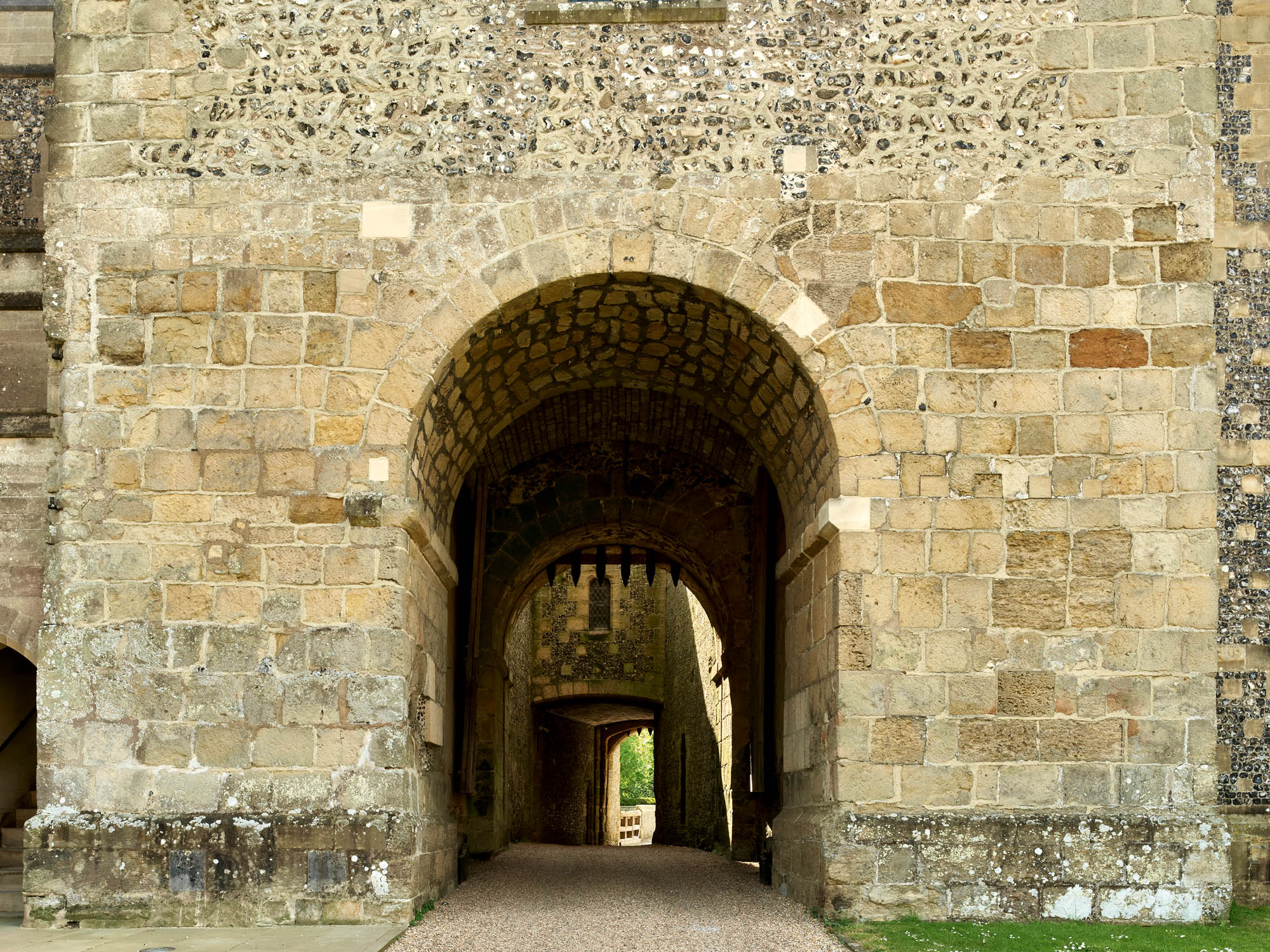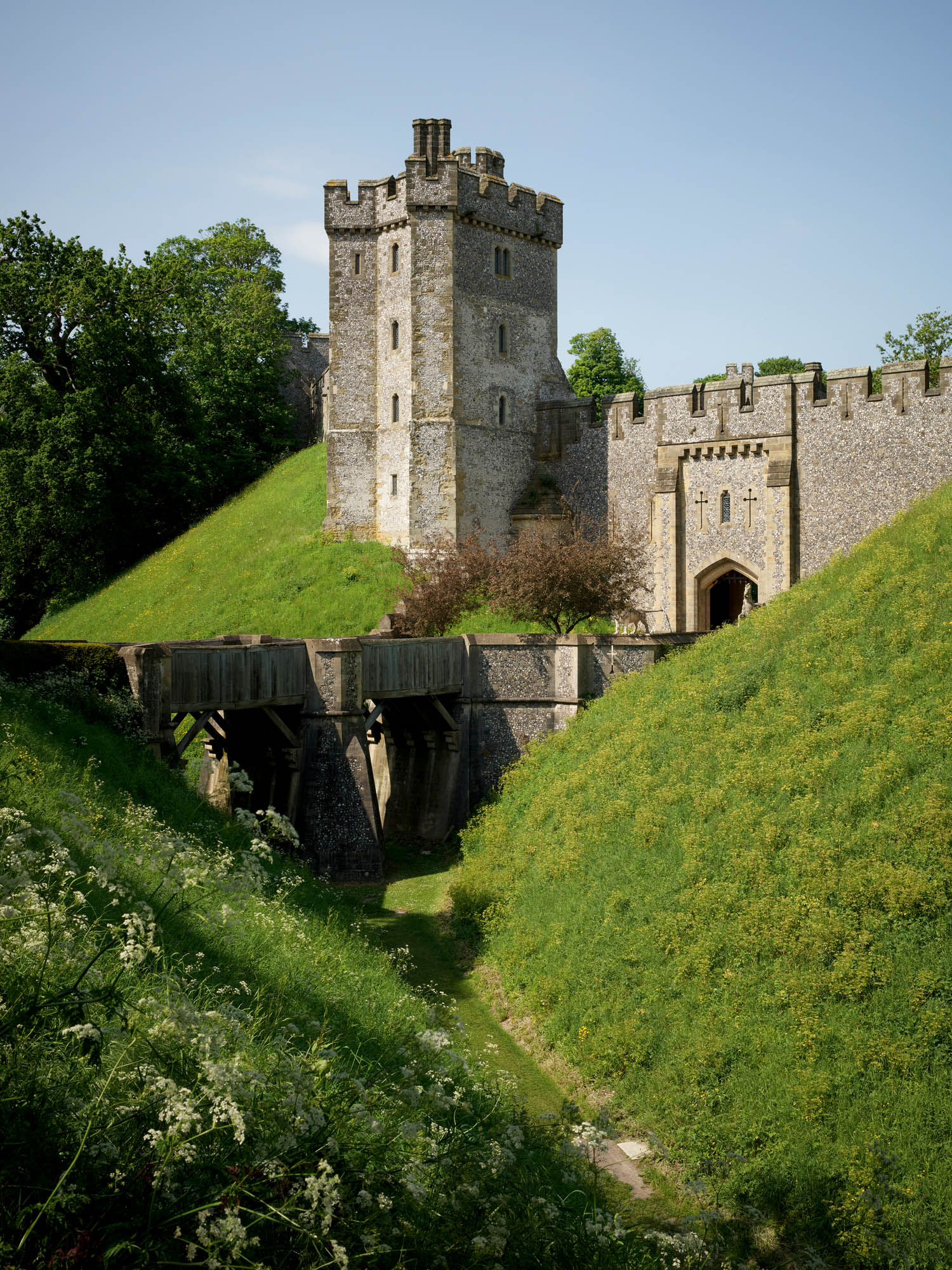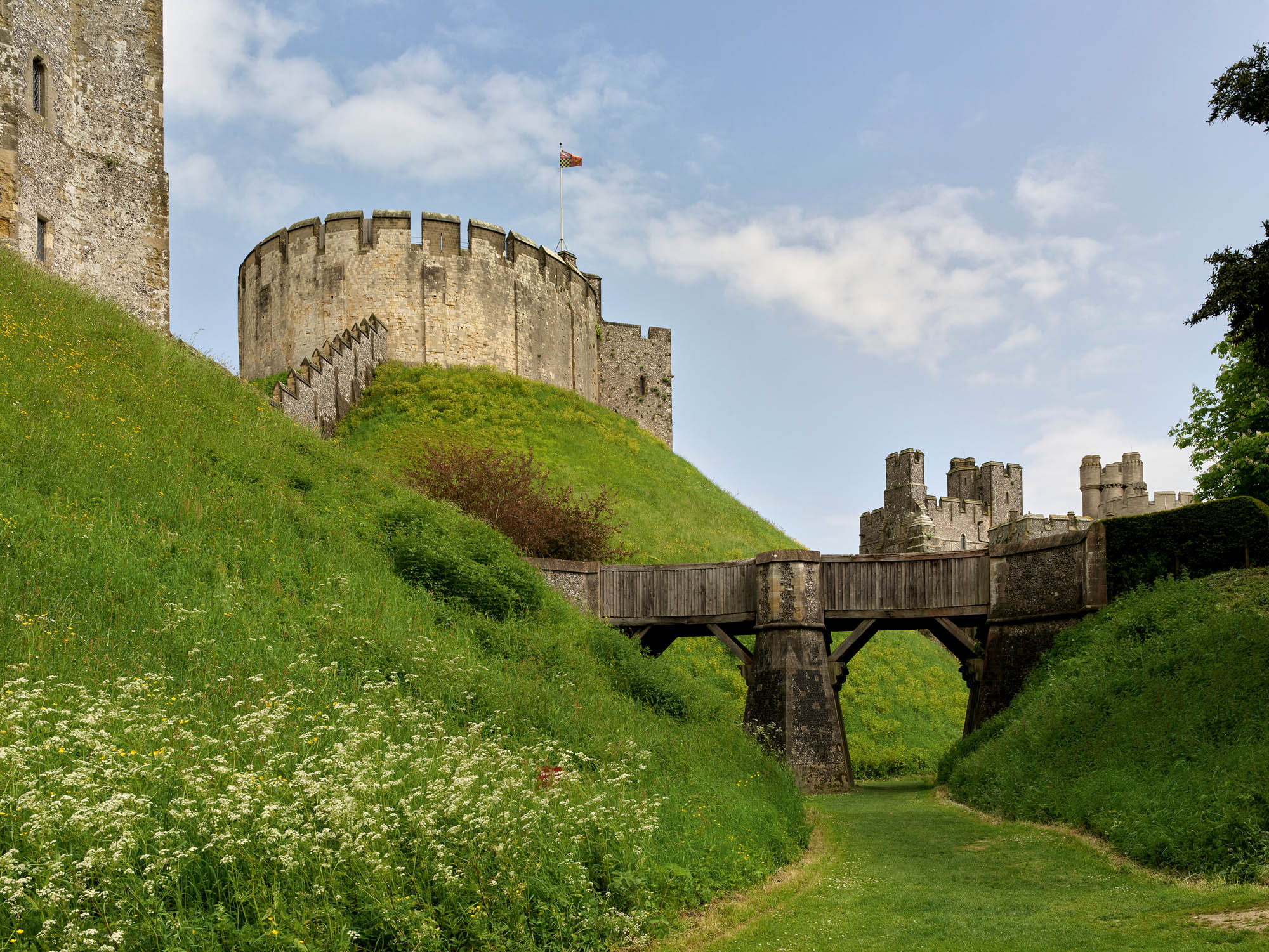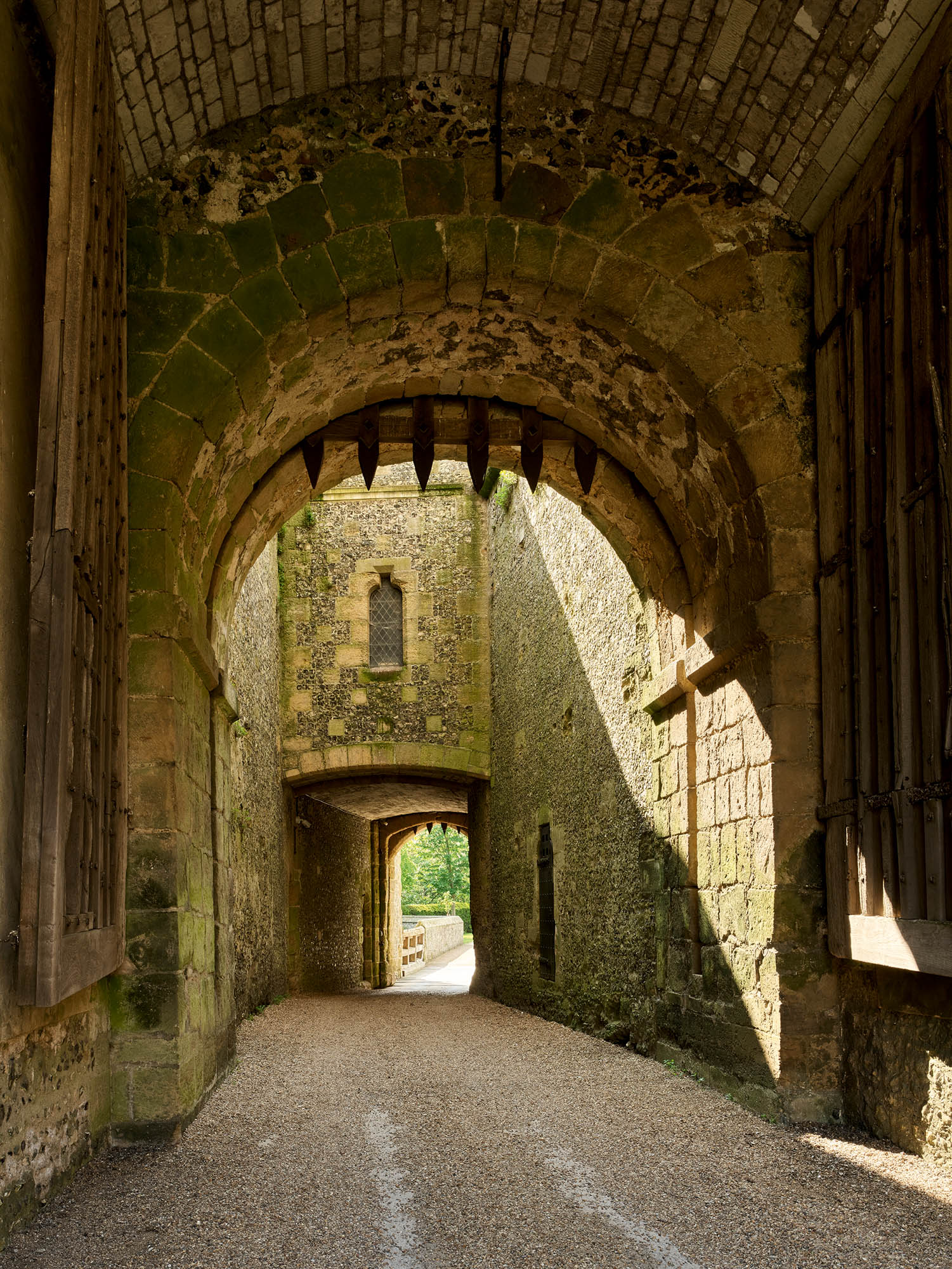Arundel Castle: The creation of one of England's great princely seats
In the first of two articles, John Goodall looks at the early development of the celebrated Arundel Castle, West Sussex, now the seat of the Duke of Norfolk, Earl Marshal, and a creation of the powerful and wealthy medieval Earls of Arundel. Photographs by Paul Highnam for Country Life.


In 1635, the eternally enthusiastic traveller and soldier Lt Hammond arrived at the ‘pretty haven’ of Arundel, ‘graced with an ancient, strong and stately castle… sweetly and naturally situated upon a graceful ascent close by a pleasant river [the Arun]’. In what he later describes as ‘this princely castle’, he enjoyed ‘a full ample and contentive view of all the stately rooms and fair towers, the delightful gardens, large wooded parks and pleasant waters’.
[Read more: The spectacular interiors of Arundel Castle]
Passing through the surviving ‘double strong gatehouse’ of the castle that served as the lodging of the constable, warder and porter, he entered a ‘spacious, large court built about every way’. To his right was a ‘lofty, large and stately old hall’, then under repair, with ‘ample pastries, kitchens and larders’ between it and the gatehouse. On the far side of the court were more fashionable domestic chambers, including ‘a spacious, goodly dining room with windows castle-like, in which hangeth a rich, curious picture with our blessed Saviour on the cross’. This was the converted medieval castle chapel with its altarpiece intact.

‘Adjoining thereunto,’ he continued, ‘is a stately long gallery, with many curious rich pictures hanging in it… many other lodgings there are, very convenient and handsome… furnished and hung with tapestry and other rich hangings.’ Where the land fell away towards the river, the rooms were raised up above ‘brave, large, arched cellars’.
From the interior, Hammond ascended to the ‘high round tower’ or keep, the centrepiece of the castle and simply called, therefore, the Arundel Tower. The building was roofless and a garden was laid out within the circuit of its wall. It overlooked an orchard with ‘fruitful appletrees, peartrees, plumtrees and filberd trees’, as well as a ‘large sweet garden… within the walls, which are round about environed with a broad deep ditch’. About this grew ‘old high trees of oak, ash and maple’ and beyond there stretched the park with deer for the jealously guarded aristocratic pastime of hunting.
Hammond would have been astonished to know that, within two decades of his visit, much of what he saw had been laid waste — although not perhaps very efficiently — by the Civil War. Despite that, the castle he describes — revived by sweeping changes and restoration in the 18th and 19th centuries — is still recognisable to the modern visitor (Fig 3).

The story of Arundel Castle stretches back to the aftermath of the Norman Conquest, when the Sussex coastline was divided into five — and later six — huge landed estates. These so-called ‘Rapes of Sussex’ were a means of creating a southern frontier to the kingdom, with the resources of each estate being directed towards the maintenance of a major castle. From east to west, the Rapes were, respectively, Hastings, Pevensey (where William the Conqueror had first landed his own invading army), Lewes, Bramber, Arundel and Chichester.
Exquisite houses, the beauty of Nature, and how to get the most from your life, straight to your inbox.
The latter two are the earliest Rapes to be documented, having been granted in 1067 or 1068 by William the Conqueror to one of his longest-serving and most faithful followers, Roger de Montgomery. Possibly at the same time, or by 1171, Roger was also granted Shropshire and the title of Earl of Shrewsbury, with the aim of likewise securing the Welsh border. There, uniquely for a Norman, he bestowed his name on both a town and a county.
Arundel was already an important Anglo-Saxon settlement and Roger planted his castle on a spur of chalk running parallel to the main street and at right angles to the Arun. He also endowed a small, neighbouring priory. The massive earthworks (Fig 4) that still encircle the castle — two ditched baileys in a figure-of-eight plan with an artificial hill or motte asymmetrically placed at their intersection — are probably his creation. They would have been furnished with timber fortifications with one important possible exception.

The main gate of the castle leading into the lower bailey incorporates the remains of what could plausibly be an 11th-century tower and entrance passage in stone (Fig 2). Secular architecture before 1100 in masonry is very rare, the material being hard to work and associated with the ruined vestiges of the Roman world. Modest as it may seem today, therefore, this fragmentary survival speaks of the exceptional importance of Arundel.
It’s an added curiosity that particular significance was attached to gate towers in the Anglo-Saxon architectural tradition as symbols of lordship. Could this stone tower — and its contemporary neighbour at Bramber — be an attempt to appropriate this idea to their respective castles?
Roger died in 1094 and his vast estates passed to his son, Robert de Bellême, who quarrelled with Henry I. In 1102, the King besieged the castle, investing it — according to the Anglo-Saxon Chronicles — with several smaller, surrounding castles. The surviving earthworks of two of these siege castles have been tentatively identified at Warningcamp and Ford. Arundel was surrendered to the King and subsequently passed into the hands of Henry I’s widow, Adeliza of Louvain. She remarried in 1138, catapulting her new husband, William d’Albini, into prominence and power.

D’Albini responded to his new-found status by pouring money into the transformation of two Norfolk possessions, Castle Rising and ‘New’ Buckenham. As part of these works he added to both castles a keep of stone, the former inspired by the magnificent royal tower at Norwich and the other on a very unusual circular plan. In 1141, however, William additionally received the title of Earl of Sussex. Arundel now became William’s seat in the county of his coveted title. It was almost certainly in order to celebrate this, therefore, that he remodelled the central motte, encircling the summit with a wall of stone to create a ‘shell keep’ (Fig 5).
The sheer quality and expense of the shell keep, with its perfectly circular plan (perhaps echoing New Buckenham), walls of cut stone, slim buttresses and a richly ornamented entrance, underlines the demonstrative quality of this building. As originally completed, the interior was lined with timber-frame buildings, now lost. Of their original form and function we know nothing, but there is a well, which implies domestic use.
During the 12th century, the castle was otherwise walled in stone. The fragmentary remains of a large-scale domestic block also survive in the lower castle bailey. Two Romanesque windows from this are prominently fossilised in the towering south wall of the castle (Fig 6). On stylistic grounds, they can be dated to the middle decades of the late 12th century, but they are usually associated with documented alterations made to the building by Henry II in 1181–83 during a brief period of royal ownership. The King’s works, as recorded in the Pipe Rolls, were substantial and comprised expenditure on the castle wall for £145 and on the chapel and ‘king’s chamber’ for £75. Four years later £12 were spent on flooring ‘the tower of Arundel’, presumably the shell keep, and creating a garden ‘before’ the king’s chamber.

In 1243, possession of Arundel passed into the hands of the Fitzalan family by marriage from Isabel, the sister and co-heir of Hugh d’Aubigny, Earl of Arundel. The interests of the Fitzalan family had hitherto been focused on the Welsh Marches and it was from this area that they continued to draw much of their wealth. They also built ambitiously, as at Clun Castle, Shropshire. By 1292, however, the Earldom of Arundel had been revived in the Fitzalan line and this probably explains why, in the 14th century, they remodelled their titular seat on the grandest scale.
Crucial to this process was the figure of Richard Fitzalan, 3rd Earl of Arundel. His interest in the castle may have been encouraged by the successful claim he laid in 1361 to property and the title — the Earldom of Surrey — of the de Warenne family, lords of neighbouring Lewes. Whatever the case, the 3rd Earl amassed quite extraordinary wealth as a soldier, councillor and diplomat in the service of Edward III. At his death in 1376, his cash reserves alone amounted to a staggering £60,000. Significantly, nearly half this unimaginable sum in coin — the equivalent of nearly 90,000 gold nobles — was stored for safety in the ‘high tower’ of Arundel Castle.
It’s possible that the 3rd Earl began the remodelling of Arundel Castle, but it was undoubtedly his namesake son, Richard, 4th Earl of Arundel and 9th Earl of Surrey, who took upon himself the lion’s share of the task to modernise the castle, using his father’s money. In the absence of other documentation, the key to understanding the chronology of this operation lies in the history of the collegiate and parish church that today stands in the castle’s shadow (COUNTRY LIFE, May 1, 2008).

In his will, dated to 1375, the 3rd Earl made a bequest of 1,000 marks towards the endowment of a chapel in the castle dedicated to St George. Devotion to this saint had recently been made fashionable in England by Edward III and his foundation of the Order of the Garter with its collegiate chapel of St George in Windsor Castle. The 4th Earl, however, conceived a more ambitious plan. He combined the bequest with the endowment of Roger de Montgomery’s priory to create a new college of priests, which he attached to Arundel’s parish church.
Work progressed with notable speed. The first college buildings were completed by 1381 and the collegiate church was consecrated in 1387. The architectural designs for the college were almost certainly drawn up by the outstanding professional of his day, the King’s Mason, Henry Yevele, who also contracted to build the 3rd Earl’s tomb at Lewes.
Many of the technical details of the collegiate church are mirrored in the castle, which must have been under construction concurrently under Yevele’s direction. It is to him, therefore, that we can attribute the 14th-century entrance tower to the shell keep (Fig 8) and — probably — the broad vaults described by Hammond in the 12th-century domestic range. Most sophisticated and impressive of all is the 11th-century gate tower (Fig 1), which was raised and extended forward to create a defensive courtyard or barbican (Fig 7). The surviving roof of this outstanding building was renewed in about 1500.

When this work was under way in the 1380s, the 4th Earl was prominent among the so-called Lords Appellant, who successfully challenged Richard II’s authority. The King suddenly revenged himself for this humiliating episode nearly a decade later in July 1397, arresting the Earl at Reigate Castle and having him tried as a traitor. At the ensuing execution, the Earl’s headless body was reported to have risen to its feet for the time it took to say the Lord’s Prayer. Subsequent rumours of miracles performed by the Earl from beyond the grave soon forced the King to exhume his corpse and rebury it secretly.
It’s possible that the arrest and execution of the 4th Earl cut short his improvements to Arundel, but we know little about the form of the castle buildings or their development during the 15th and 16th centuries. Famously, in that period, the estate of the Fitzalans was absorbed by marriage into the patrimony of the Howard family, the Dukes of Norfolk and Earls of Arundel, in whose hands it still descends. This continuity is the more remarkable because of the family’s persistent recusancy: Philip Howard, 13th Earl, died a Catholic martyr in the Tower of London in 1595. The aforementioned Hammond’s description of 1635 constitutes the most complete account of the castle in its late-medieval form.
During the Civil War, the castle fell to Parliament after a short siege in 1643 and, in 1653, order was given for it to be slighted. Between these two events, in 1644, when its future hung in the balance, an engraving of the castle was made by Bohemian artist Wenceslaus Hollar. His view was almost certainly commissioned by Thomas Howard, the celebrated ‘Collector’ Earl of Arundel, as a record of his titular seat. This shows the main domestic buildings clustered in the lower bailey and, among them, the great hall with a massive pitched roof, battlemented parapets and stepped gables.

It was in this lost interior in 1635 that Hammond particularly marvelled at an heirloom that linked the castle to the chivalric legend of the hero Bevis and the giant Ascupart. The history of any great castle necessarily extends into the fantastical. ‘I cannot let pass,’ he wrote, ‘without some remark, the stately sword or hanger of that valiant and undoubted warrior, which is 2 yards long and 2 inches broad, and which to be shown me, was drawn against me (though not in anger), wherewith (as some say) he vanquished that huge and mighty giant.’
Remarkably, the modern visitor can still encounter this heirloom — in fact a 14th-century sword — in the splendidly redisplayed interiors of the castle, which are the object of next week’s article.
Visit www.arundelcastle.org to find out more about visiting hours.
Country Life's architectural editor John Goodall and our illustrious contributing writers discuss Britain's greatest architecture in the magazine every week. Find out how to subscribe to the magazine here.

John spent his childhood in Kenya, Germany, India and Yorkshire before joining Country Life in 2007, via the University of Durham. Known for his irrepressible love of castles and the Frozen soundtrack, and a laugh that lights up the lives of those around him, John also moonlights as a walking encyclopedia and is the author of several books.